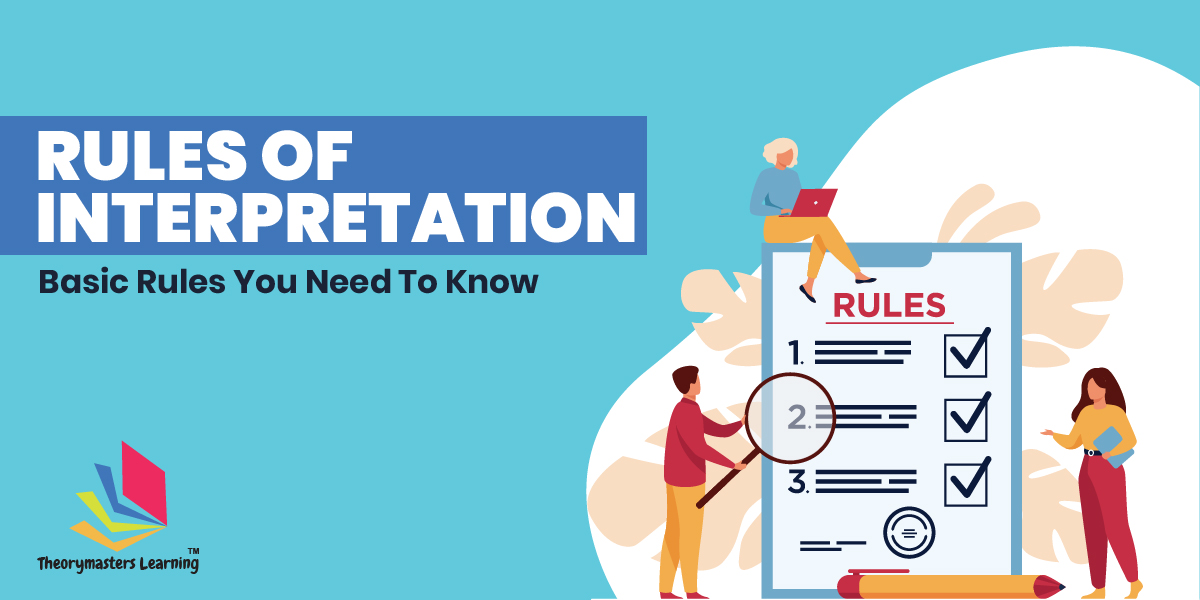Rules of Interpretation- Basic Rules You Need To Know

This Article is written by CA Preeti Aggarwal,an eminent faculty providing CA foundation and CA inter law video lectures through her website www.capreetiaggarwal.com. In this article, she discusses the meaning and rules of interpretation.
| Table of Contents: |
| 1. Meaning of Interpretation |
| 2. Need for Interpretation |
| 3. Rules of Interpretation of Statutes |
| A) Primary Rules- can be further sub-divided into: |
| (1) Rule of Literal Construction |
| (2) Rule of Reasonable Construction |
| (3) Rule of Harmonious Construction |
| (4) Rule of Beneficial Construction |
| (5) Rule of Exceptional Construction |
| (6) Rule of Ejusdem Generis |
| B) Secondary Rules- can be further sub-divided into: |
| (1) Effect of Usage |
| (2) Associated words to be understood in common sense manner |
| 4. Conclusion |
- Meaning of Interpretation
The term has been derived from the Latin term ‘interpretari’, which means to explain, expound, understand, or to translate.the process by which the Courts seek to ascertain the meaning of the legislature through the medium of the words in which it is expressed.
Simply stated, Interpretation of statutes is the correct understanding of the law. This process is commonly adopted by the courts for determining the exact intention of the legislature.
Interpretation is resorted to in order to resolve any ambiguity in the statute. It is the art of finding out the true sense of words that is to say the sense in which their author intended to convey the subject matter. - Need for interpretation
Texts are of different nature e.g. religious texts, philosophical texts, literary texts, historical texts and statutory texts, therefore, there exist different types of skills which help in understanding the texts of these different nature.
Language is considered as the most important invention of human beings but as a matter of fact it is the most unsuccessful medium of communication, as it is full of ambiguities, vagueness and incorrectness.
As all the statutes are drawn up in form of language, therefore, these problems are inherent in statutes as well, which will give rise to uncertainty and inexactness.
Hence, there will always be a need of interpreting statutes so that their correct meaning may be ascertained as was intended by the legislature. - Rules of Interpretation of statutes
Over a period, certain rules of interpretation /construction have come to be well recognized. However, these rules are considered as guides only and are not inflexible. These rules can be broadly classified as Primary Rules and Secondary Rules of Interpretation.
A) Primary Rules- can be further sub-divided into:
(1) Rule of Literal Construction
(2) Rule of Reasonable Construction
(3) Rule of Harmonious Construction
(4) Rule of Beneficial Construction
(5) Rule of Exceptional Construction
(6) Rule of Ejusdem Generis.
B) Secondary Rules- can be further sub-divided into:
(1) Effect of Usage
(2) Associated words to be understood in common sense manner
A) Primary Rules
1) Rule of literal construction
– Words, sentences and phrases of a statute should be read in their ordinary, natural and grammatical meaning so that they may have effect in their widest amplitude (scale).
– When the language of the statute is plain and unambiguous and admits only one meaning, no question of construction of a statute arises, for the Act speaks for itself.
– Where the language is plain and admits only one meaning, there is no room for interpretation and only that meaning is to be enforced. This is the golden rule of interpretation which says that the words of a statute must prima facie be given their ordinary meaning.
– It is yet another rule of construction that when the words of the statute are clear, plain and unambiguous, then the courts are bound to give effect to that meaning, irrespective of the consequences.
– If there are two possible understandings of a clause, one a mere mechanical and literal construction based on the rules of grammar and the other which emerges from the words, setting and circumstances in which the clause was enacted, the courts may prefer the second construction, which, though may not be literal, may be a better one.
This rule of literal interpretation can be read and understood under the following headings:
A) Natural and grammatical meaning
- Statutes are to be first understood in their natural, ordinary or popular sense and must be construed according to their plain, literal and grammatical meaning
- The statutes may be modified, extended or abridged only if it involves absurdity or inconsistency
B) Explanation of the rule
- When it is said that words are to be understood first in their natural, ordinary or popular sense, it is meant that the words must be qualified in their natural, ordinary or popular meaning which they have in relation to the subject matter with reference to which they have been used in the statue.
- The meaning of a word depends upon the text and context.
C) Exact meaning preferred to loose meaning - Exact meaning is preferred to loose meaning in an Act of Parliament.
- Since every word has a secondary meaning too, one should be careful not to mix up secondary meaning with the loose meaning.
D) Technical words in technical sense - Technical words must be understood in the technical sense only
2) Rule of reasonable construction
- The words of a statute must be construed asto lead to a sensible meaning.
- While interpreting a law, two meanings are possible, one making the statute absolutely vague and meaningless and other leading to certainty and a meaningful interpretation. In such case the later interpretation should be followed.
- If the court finds that giving a plain meaning to the words will not be fair or reasonable construction, it becomes the duty of the court to depart from the dictionary meaning and adopt the construction which will advance the remedy and suppress the mischief.
3) Rule of Harmonious construction
- An effort should be made to interpret a statute in such a way as harmonizes with the object of the statute
- This is known as the rule of harmonious construction.
- When there is doubt about the meaning of the words of a statute, these should be understood in the sense in which they harmonize with the subject of the enactment and the object which the legislature had in view.
- The sections and sub-sections of the statue must be read as parts of an integral whole and being inter-dependent. Therefore, importance should not be attached to a single clause in one section overlooking the provisions of another section.
- If it is impossible to avoid inconsistency, the provision which was enacted or amended later in point of time shall prevail.
- The rule of harmonious construction is applicable only when there is a real and not merely apparent conflict between the provisions of the Act.
- Thus, when the words are capable of only a single meaning, the rule of harmonious construction disappears and is replaced by the rule of literal construction.
4) Rule of beneficial construction or the Heydon’s Rule
- Where the language used in a statute is capable of more than one interpretation, the principle laid down in the Heydon’s case shall apply.
- The rule which is also known as ‘purposive construction’ or ‘mischief rule’ enables consideration of four matters in construing an Act:
(a) What was the law before making of the Act?
(b) What was the mischief or defect for which the law did not provide?
(c) What is the remedy that the Act has provided?
(d) What is the reason for the remedy?
- The rule then directs that the courts must adopt that construction which shall suppress the mischief and advance the remedy.
- The rule in Heydon’s case is applicable only when the words used are ambiguous and are reasonablycapable of more than one meaning.
Watch this video to know more about the Rule of beneficial construction
5) Rule of Exceptional construction
A) The Common Sense Rule
- Despite the general rule that full effect must be given to every word, if no sensible meaning can be fixed to a word or phrase, or if it would defeat the real object of the enactment, it should be eliminated.
- However, if possible, and sensible meaning should be attached to those words, as it is better for a thing to have effect than to be made void.
B) Conjunctive and disjunctive words ‘or’ ‘and’:
- The word ‘or’ is normally disjunctive and ‘and’ is normally conjunctive.
C) ‘May’, ‘Must’ and ‘shall’:
(i)‘May’:
- The word ‘may’ generally denotes that the provision is discretionary in nature.
- However, whenever the object of the power is to give effect to a legal right, the use of the word ‘May’ would not show that the provision is directory in nature.
- Sometimes, the legislature may use the word ‘may’ as a matter of pure conventional courtesy and yet intend a mandatory force.
- Therefore, in order to interpret the legal import of the word ‘may’, we have to consider various factors
- When a discretion is conferred upon a public authority coupled with an obligation, the word ‘may’ should be construed to mean a command.
(ii) Shall:
- Generally speaking, when a statute uses the word ‘shall’ prima facie it is mandatory, unless the context or intention demands otherwise
- Hence, under certain circumstances the expression ‘shall’ is construed as ‘may’.
- The use of word ‘shall’with respect to one matter and use of the word ‘may’ with reference to another matter in the same section of the statute will normally lead to the conclusion that the word ‘shall’ imposes an obligation, whereas the word ‘may’ confers a discretionary power.
Watch this video to know more about mandatory and discretionary provisions
6) Rule of Ejusdem Genesis
- The term ‘Ejusdem Genesis’ means ‘of the same kind or species’
- Simply stated, the rule means that where specific words are used and after those specific
words, some general words are used, the general words would take their colour from the specific words used earlier
B) Other (Secondary) rules of interpretation
1) Effect of usage
- The custom is the best interpreter of law.
- The best way to interpret a document is to read it as it would have been read when made.
- Old statutes and documents should be interpreted as they would been at the time when they
were enactedor written.
2) Associated words to be understood in common sense manner
- The meaning of a word is to be judged by the company it keeps
- When two or more words which are capable of similar or parallel meaning are coupled together, they are to be understood in their cognate sense (i.e similar in origin, nature or quality)
5. Conclusion
Enacted laws, Acts and Rules are drafted by legal experts and so it is expected that the language used will leave little room for interpretation of construction.
Interpretation or construction of statutes helps in finding of the meaning of ambiguous words and expressions given in the statutes and resolving inconsistency lying therein. If any provision of the statute is open to two interpretations, the Court has to choose that interpretation which represents the true intention of the legislature.
The best interpretation of statutes is possible by adoption of various guiding rules of construction and aids to construction of statutes.

For Lectures visit www.capreetiaggarwal.com
Follow CA Preeti Aggarwal on Instagram :









